Ripnlic P-84 Thunderjet / Thunderstrike / Thunderflash. Part I. "Jet Thunder" over Korea
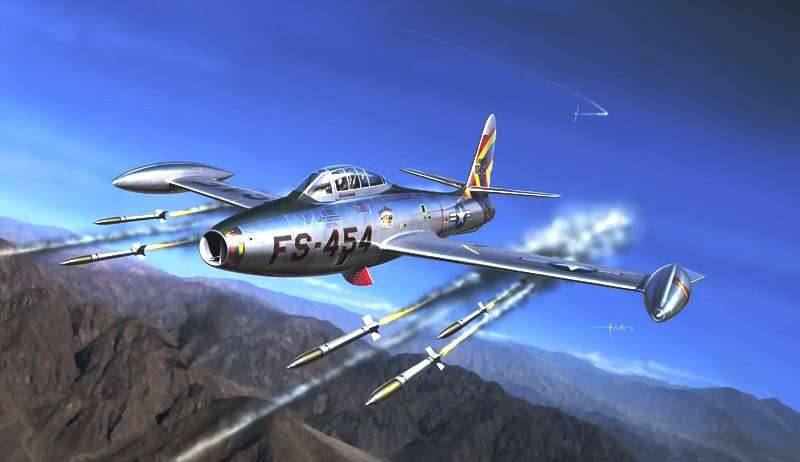
The family of jet fighters and reconnaissance companies Ripablik "Thunderjet", "Thunderstrik" and "Thunderflash" has been dating back to 1944, when the company began the initiative to develop a jet plane designed to replace the famous P-47 "Thunderbolt". At first, Alexander Kartveli and his designers planned to install the turbojet engine directly on the P-47 glider, but it was soon decided to create a fundamentally new car. The choice was made on a low-wing scheme with a straight wing having a laminar profile and a stabilizer, which was mounted on the keel. From the bottom of the fuselage, directly under the cockpit, was installed air brake of large dimensions. The turbojet General Electrician TG-100 (J35) was chosen as the engine. This engine had an axial compressor, which allowed for greater pressure at the inlet to the combustion chamber and reduced fuel consumption, compared with motors with a centrifugal compressor. In addition, such a TRD had a smaller cross-section, which facilitated the layout of the fuselage. The air intake was located in the nose. The hermitabine had a drop-shaped lantern and was equipped with an ejection seat.
Since the flight range was no less important than speed, it was decided to choose a relatively thick wing profile to accommodate fuel tanks. As a result, the critical Mach number was reached on the wing earlier than on the fuselage. So the thick wing became the main limiting factor in the growth of flight data of the first models of the new fighter.
The United States Army Air Force favored the project by ordering three experimental and 1945 production vehicles in March 400. They were given the designation P-84 "Thunderjet". It is worth noting that, in anticipation of victory in the Pacific, it was decided to suspend the execution of a number of orders in order to make the necessary corrections in the post-war situation. Most of the orders were canceled altogether, but as for the P-84, the US Army Air Force 15 January 1946 confirmed the 15 YP-84 order for military tests and the 85 serial P-84B.
The first XP-84 was completed in December 1945 of the year. The aircraft was equipped with a J35-GE-7 General Electric engine XG kg kg. The prototype, partially disassembled, was loaded onto a Boeing XC-1702 cargo plane and transported from the company's factory in Fermingdale, New York, to Myurok air base in California. The XP-97 first pulled away from the runway at the end of February 84, under the command of Major William Lien. It was the first new American fighter to take off after the end of the Second World War.
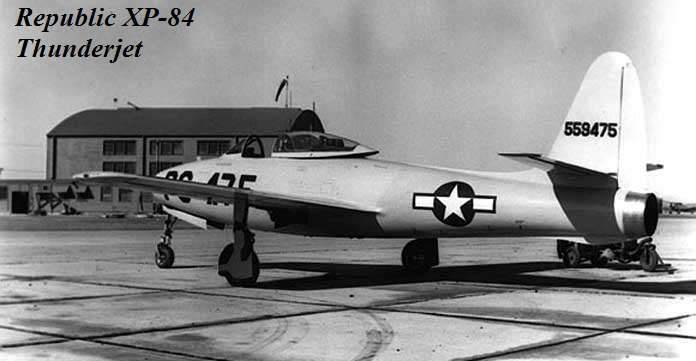
On tests XP-84 reached the maximum speed of 947 km / h from the ground. The height in 10675 m was typed in 13 minutes. Normal flight range was 2080 km. The second prototype was circled in August 1946. On it, the 7 of September, the Americans set a new world speed record, reaching 978 km / h. However, on the same day this record was broken by the English fighter Gloucester "Meteor", which showed the speed of 986 km / h.
The 15 pre-production Thunderjet series was designated YP-84A. The US Air Force delivered them in April 1947 of the year. They were equipped with an Allison engine J35-A-15 kg 1703. The armament consisted of six 12,7-mm machine guns - 4 were placed in the nose of the fuselage, and two in the wing. YP-84 were sent to the Murok test center or to Wright-Paterson Air Base, where they were tested, as well as pilots training.
The first production version of Thunderjet, as already mentioned, was the P-84B. They installed the Allison J35-A-15С engine with a load increased to 1816 kg. The P-84B differed from the YP-84A in the first place by the installation of an ejection seat. On the plane also put a radio compass and new machine guns M-3 instead of the model M-2.
The new order, concluded in June 1947, provided for the delivery of another 141 P-84В, starting with the 21 series. On new machines, weapons were added with console retractable launchers for eight 127-mm missiles. The deliveries of serial cars began in the summer of 1947-th to the 14-th fighter group at Dowfield. The last P-84B was delivered in February 1948 of the year.
On June 11, 1948, the designation P-84B was changed to F-84B. 80 retired in the fifties F-84B transferred the fleet USA, where they were converted into flying targets. The aircraft were renamed the F-84KX.
Two copies of the F-84B were used in work on the composite aircraft - they docked in the air to the wing tips of the EB-29А. It was planned in this way to increase the flight range of escort fighters, towing them to the target by bombers. However, 24 on April 1953, a bunch of three aircraft crashed, and the project was soon discontinued as too risky. The company planned to produce at least 500 F-84В aircraft, but after manufacturing 274 machines, the Air Force demanded a new modification of the fighter. Serious shortcomings were the cause: the fuselage skin was not thick enough (in places it was barely reaching 0,8 mm), it literally frowned when flying at high speeds. In addition, there was a regular shortage of spare parts and parts. Also, the aircraft was extremely difficult to maintain. Ground composition nicknamed F-84V - "The Nightmare of Mechanics."
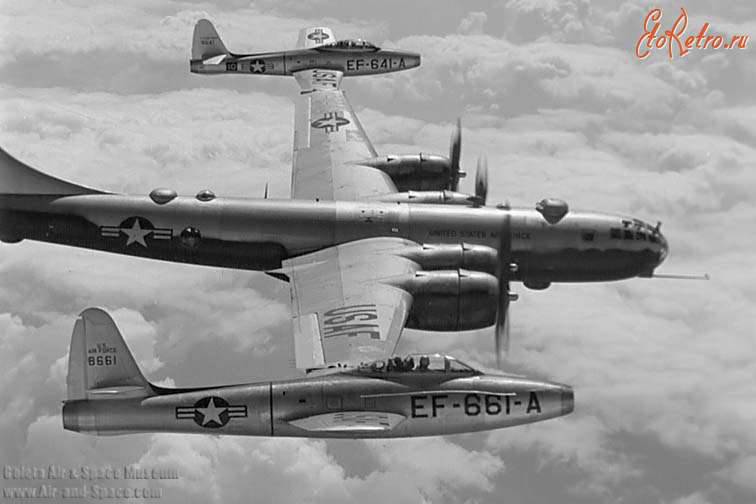
The next production version of the Thunderjet was the F-84C. The aircraft was very similar to the F-84B and differed with the corrected wing and Allison J35-A-13С engine, instead of the same thrust 15С. The A-13 was primarily more reliable. Also, the aircraft received a new electrical system and a simplified fuel system. In June, the 1947, the Air Force, ordered the 191 fighter of a new modification. Deliveries of vehicles began in the spring of 1948, and the first one entered the 20 th fighter group at Shoyu airbase. With the advent of the new modification, “nightmare” for the technical staff has become a “nightmare” for pilots as well. In the midst of the mass production of the Thunderjet, numerous accidents forced the US Air Force to stop flying F-84 fighters. Problems arose when performing maneuvers at high speeds. At speeds less than 800 km / h and overloads to 4g (i.e., overloads are more suitable for a bomber than a fighter), the Thunderjet behaved well, but when they were exceeded, the rocket engine turned into an unguided projectile. It turned out that in flight, outboard tanks displace the aerodynamic focus and change the wing twist, which leads to an increase in the angle of attack. This is accompanied by a drop, practically to zero, of the force on the control stick, and causes the pilot to feel an absolute loss of controllability. Specialists of the company had to use complex integrated measures to combat this shortcoming. The thickness of the wing skin was increased, the torsion was reduced, and in addition triangular wings mounted on the tanks shifting the aerodynamic focus. After the modifications, flights on Thunderjet were allowed. But the representatives of Ripablik didn’t have much time to rejoice. In mid-September 1948, the Air Force specialists conducted an inspection of the F-84 aircraft in combat units. The Commission concluded that F-84B and F-84C do not meet the requirements of the Air Force and are not able to perform combat missions.
The next serial modification was the F-84D. It installed a more powerful TRD Allison J5-A-17D 2270 kg. There were other improvements: the plane received an even thicker plating of the wing planes and ailerons, was equipped with a fuel system, for operation at low temperatures and mechanical wiring in the landing gear cleaning system, instead of hydraulic. The pitot tube has moved from the keel to the central air intake partition. Access panel to the weapons bay is now hinged on its hinges.
The next in the series went F-84. The aircraft received a structurally redesigned fuselage, which was extended by 30 cm, which made it possible to more comfortably place the pilot in the cockpit. The aircraft received a radio range finder Sperry ARG-30, improved end fuel tanks were developed. For the suspension of the starting powder accelerators, retractable holders were installed under the rear part of the fuselage. This made it possible to raise the take-off weight of the aircraft to 10196 kg. The internal fuel supply has increased from 1577l to 1713l. At the wingtips, the suspension of two 872-l fuel tanks was possible, which made it possible to increase the maximum range to 2376 km. In addition, it was possible to hang a couple more of the same tanks under the inner wing holders. With four tanks, the range was 3120 km.
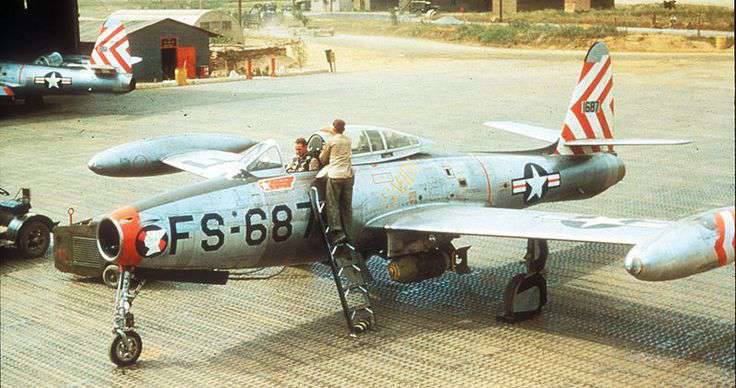
The F-84E was ordered on December 29 1948 of the year, and on May 18 the first aircraft of this model took off. Total was released 1949 "Thunderjet" modification "E". These machines were armed with most of the six wings with F-843, met the war in Korea. They carried out their first combat sortie on 84 on December 7 of the year as part of the 1950 th escort fighter group, which re-armed with the Twin Mustangs of the F-27, just a couple of months before.
F-84Es from the 27 group were used to cover the B-29 bombers, often meeting in battles with the MiG-15. The first victory over the MiG-15 on the F-84 was announced on 21 on January 1951. However, the F-84, having a straight wing could not fight with the MiG due to insufficient flight speed. As a result, MiGs quite easily broke through the escort fighters to their wards B-29, taking the last heavy losses. In total, the F-84E pilots announced the destruction of nine MiG-15 during the air battles, with the loss of the Thunderjet 18. So, even according to American data, the loss ratio was 2: 1 is not in favor of Thunderjet. October 30 1951-th US Air Force suffered the most significant defeat for the entire Korean War. The main "heroes" of that day were 89 "Thunderjet" and 21 B-29. The combat mission of these machines was the bombing of the airfield of Nancy. However, they were intercepted by 44 MiG-15 Soviet 303 and 324. Our fighters attacked B-29 Stratofortress in pairs, breaking into a dive at high speed through the Thunderjet formation. The American pilots turned away in order not to be attacked by the MiGs themselves. In the very first attack of the MiG-15, 12 bombers were shot down. The remaining American B-29 dropped their bombs anywhere, and turned towards the sea. It should be noted that among those flying to the base B-29, many had serious damage. In addition, a lot of damage was done to the crews (55 dead and 12 injured). On the Soviet side, only one MiG-15 was lost.
The task of fighting MiGs was assigned to a more efficient fighter - the F-86 Saber, and the Thunderjacks were transferred to delivering bomb-assault strikes - tasks that those in Korea coped with more adequately. F-84 replaced the outdated F-80 in the 49 th, 58 th, 116 th and 474 th wing. In total, F-84E, and then F-84G, made 86400 sorties in Korea, dropping 55897 tons of bombs. The United States recognized the loss of the Thunderjet 144, of which 135, according to the Americans, was shot down by anti-aircraft artillery.
Autumn 1950 Tactical aviation command began to study the possibility of using the F-84 as a tactical nuclear carrier aircraft weapons. This variant received the designation F-84G, which was considered at first only as an intermediate model of a fighter in anticipation of the start of production of the version equipped with an arrow-shaped wing - F-84F "Thunderstrike". However, the delay in work on the latter led to the continuation of production of the F-84G until 27 in July of the 1953 year, with the result that the F-84G became the most massive model of the P / F-84 family - 3025 machines were released.
The F-84G differed from the previous Thunderjet variants in a more powerful TRD Allison J35-A-29 2542 kg. The plane had the opportunity to carry on the external load to 1800 kg bombs. An in-flight refueling system was provided - the fuel intake boom was located on the left wing. Since the F-84G was planned to be used at the maximum range, the aircraft was equipped with an autopilot. The most striking change was the new, enhanced cockpit lantern with a cover, instead of a “clean” lantern on previous models. However, the new lamp did not become a distinctive feature of the G model only - later it was installed on the previously released modifications of the aircraft.
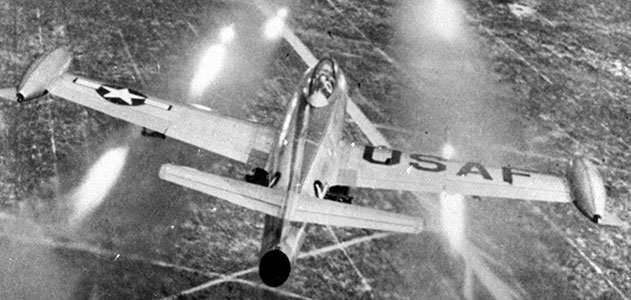
The first F-84G was delivered to the USAF in June 1951 of the year. Most of them entered the Tactical and Strategic Aviation Command, both in the States and in Europe, but appeared only sporadically in Korea. In 1952, the 49 1-wing airborne division (20 Fighter Bomber), equipped with F-84G, was deployed in the UK. They were also used in the Strategic Command as escort fighters. Flying aerial refueling began in the 1952 year.
In the 1953, the thunder-wing winged Thunderjet was in service with the 14 of the US Air Force. F-84G, adapted as carriers of nuclear weapons, practiced low-altitude bombing, when the plane reached the target at low altitude, abruptly went to a pick-up before the target, dropped the bomb, and then did the immelman and went back along the same route.
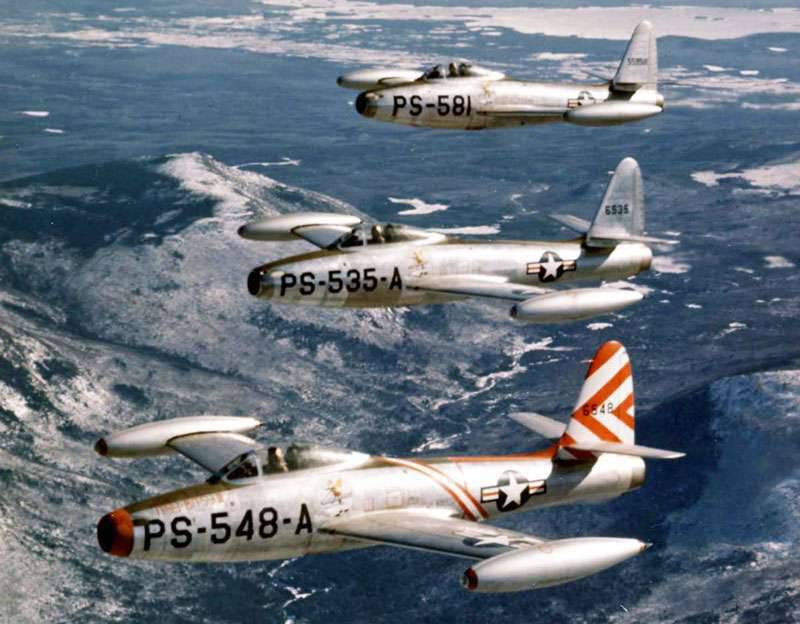
A total of 3025 fighters of this modification were released, and the total release of the Thunderjacks with a straight wing made up 4455 machines. Of these, the 1936 model “G” aircraft were delivered to US allies in NATO, as well as other countries, under the military assistance program (MDAR). Since the cars were ordered by MDAR expenditures, they received American serial numbers, although they were never used as part of the US Air Force. By 1953, the orbiting "Thunderjet" were in the 21 fighter bombing of the NATO air forces. F-84G were in service with the Air Forces of Belgium, Denmark, Norway, Holland, France, Italy, Greece, Turkey, Portugal and Taiwan. Machines of the “G” version were also supplied to “non-union” countries, such as Yugoslavia, Iran and Thailand. Since Yugoslavia was considered a "communist" country, F-84G exports there were accompanied by quite serious frictions in the US government.
The F-84G began to be decommissioned by the Strategic Command in 1956, but continued to be widely used by the Tactical Command. By the end of 1959, almost all of them had already been replaced by F-84F "Thunderstrike" with swept wings.
Work on the swept-wing version of the F-84 began in the 1949 year, in order to raise the outdated flight data of the Thunderjet to the level of the new F-86 Saber. However, it was expected that this would not entail a decrease in the bomb load of the aircraft and even improve its capabilities when attacking ground targets. At that time, the United States Air Force, “swelling” mad funds into strategic bomber programs, was hampered in free funds for developing new combat aircraft of other classes, and the planned improvements made it possible to save up to 57% of production equipment and components from previous versions of “Thunderjet”, which led to the lowest possible cost.
The F-84 variant with the swept wing was designated the XF-96A, as it had quite strong differences in design. The USAF ordered one prototype aircraft. To finalize the last car was selected model F-84E. The XF-96A fuselage had practically no differences from the orthoptera modification, including the cockpit canopy and the ventral air brake. The tail plumage has become swept. The wing was a completely new design with 38,5 ° sweep. Its area was 30,23 square. m, and the span - 11,11 m. The relative thickness of the wing was 9%. The engine was Allison J35-A-25 2542 kg.
The production of the experienced XF-96 took entire 167 days. He was dismantled and transported on a transport plane from Farmingdale to Myurok. There he was assembled and flown around 3 on June 1950 of the year, under the control of the pilot responsible for the flight tests of the company Otto Has. The plane showed the ground speed of 1109 km / h (0,93 M). At a cruising speed of 823 km / h, the flight range was 2745 km. The maximum fuel supply, including the outboard sides, reached 5690 l. The weight of the empty car was 5516 kg, the maximum take-off - 10600 kg. Although the speed at the ground was high, with increasing flight altitude the flight characteristics decreased markedly. The ceiling was only 11680 m, and the height in 10675 m was typed in 14,8 min. Since the flight data compared with the F-84E increased slightly, project work progressed slowly.
If it were not for the war in Korea, the XF-96A would have been abandoned. The beginning of the war immediately opened up the opportunity for the US Air Force to begin full-scale funding, and as early as July 1950, a preliminary contract was prepared for the completion of the development and the start of serial production of the F-96A. 9 August 1950 fighter received the designation XF-84F and the name "Thunderstrike." It was expected that the first serial "Thunderstriks" will go into service in the fall of 1951.
To be continued ...
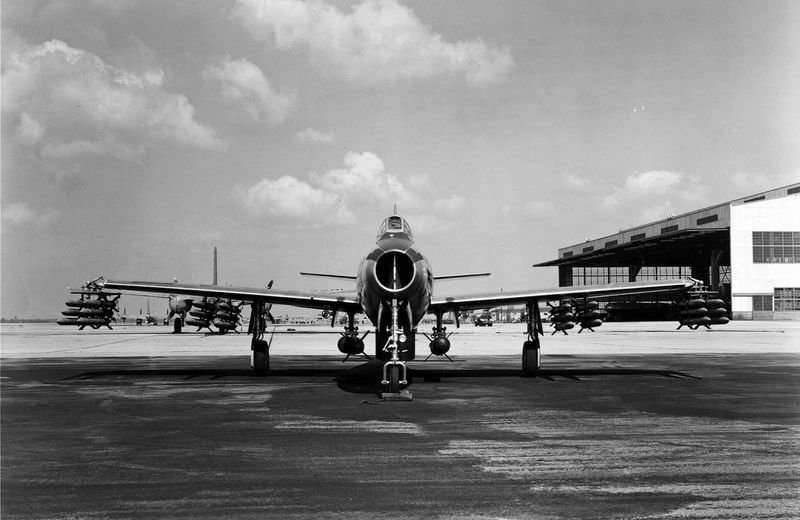
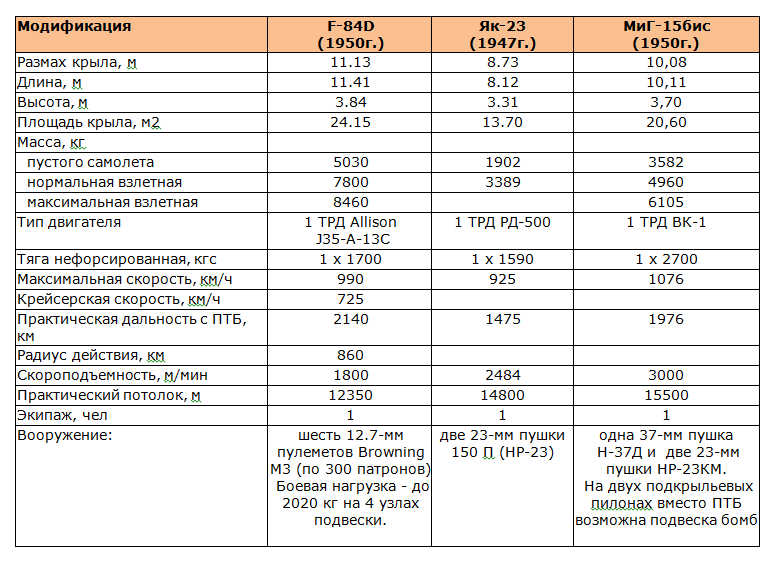
Sources:
Chechin A., Okolelov N. F-84. "Jet Thunder" over Korea // Wings of the Motherland. 1997. No.2. C. 13-19.
Green W., Cross R. Jet aircraft of the world. M .: Publishing house of foreign literature, 1957. C.142-143, 177-178.
Chechin A., Okolelov N. Reactive in Korea // Model Designer. Special edition. 2005. No.1. C. 17-32.
Firsov A. US Fighters // Aviation Collection. No.14. C. 48-52.
A. Chechin, N. Okolelov. F-84 Starfire Fighter // All Korean War Jets. M .: Yauza, 2014. C. 32-45.
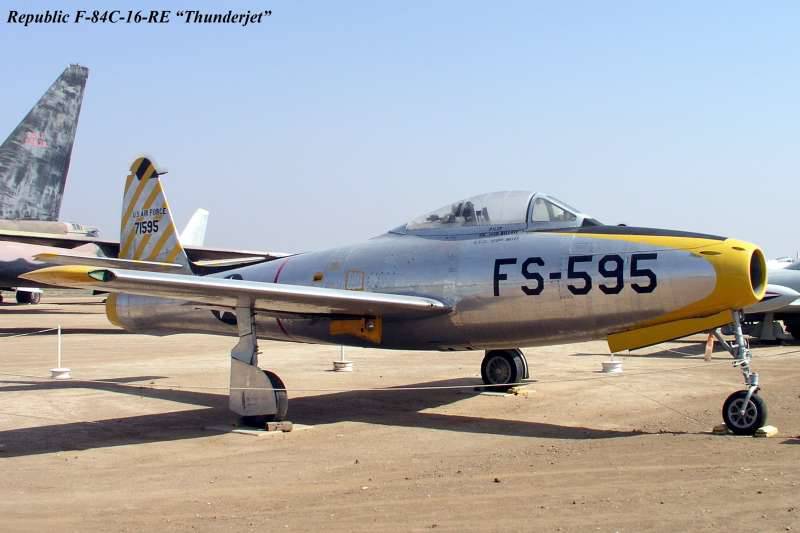
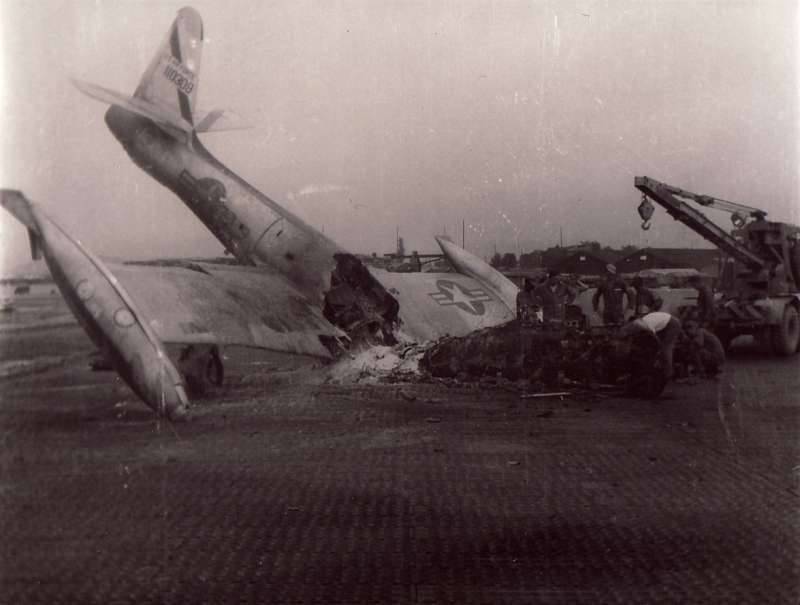
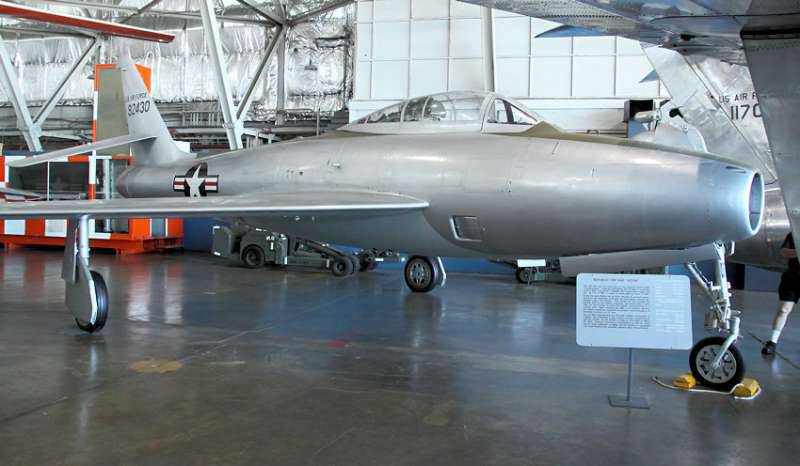
Information